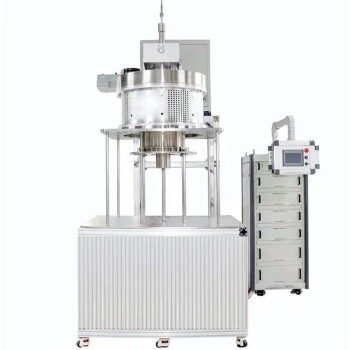In short, meticulous maintenance records are essential for ensuring the long-term reliability and consistent performance of your Microwave Plasma Chemical Vapor Deposition (MPCVD) equipment. These records transform maintenance from a simple checklist into a powerful diagnostic tool, allowing you to track the operating status of the system, identify problems early, and correlate system health directly with the quality of your crystal growth.
The core purpose of maintenance records is to shift your team from a reactive "firefighting" mode to a proactive state of process control. By logging detailed data, you create a performance history that helps you predict failures, troubleshoot inconsistencies, and ultimately guarantee higher-quality material output.
From Reactive Fixes to Proactive Control
The ultimate goal of any MPCVD process is to produce high-quality, high-purity crystal materials. Achieving this requires extreme stability and control. Maintenance records are the foundation of that control.
Establishing a Performance Baseline
You cannot identify an abnormal condition if you haven't defined what is normal. Consistent record-keeping builds a detailed baseline of your equipment's healthy operating parameters.
This includes tracking everything from exhaust fan noise to filter replacement frequency. When a deviation occurs, your records make it immediately obvious.
Correlating Maintenance to Material Quality
Maintenance records allow you to draw direct lines between the physical state of the machine and the results of a growth run.
For example, a log might show that the exhaust system required cleaning more frequently over the last month. If you simultaneously see a drop in crystal purity, you have found a likely cause: inefficient removal of contaminants from the chamber.
Predicting Failures and Preventing Downtime
Patterns in your maintenance logs are early warning signs. A component that requires service at an increasing frequency is a component that is nearing failure.
By tracking this data, you can schedule a replacement during planned downtime instead of suffering a catastrophic failure mid-process, which can ruin a valuable run and cause extensive delays.
The Hidden Costs of Poor Record-Keeping
Failing to maintain proper logs is not a neutral act; it introduces significant risk and inefficiency into your operations. The "trade-off" for saving time on paperwork is a steep price paid in equipment performance and reliability.
Increased Diagnostic Time
Without a historical record, every new problem becomes a ground-zero investigation. Engineers must re-discover information that should have been readily available, wasting valuable time and resources trying to diagnose the root cause of an issue.
Inconsistent Crystal Quality
Untracked variables lead to unpredictable outcomes. A slow degradation in the exhaust system, a minor leak at an interface, or increased vibration in a fan can all subtly impact the growth environment. Without records, these changes go unnoticed, leading to inconsistent and unreliable material quality.
Shortened Equipment Lifespan
Minor issues that are not tracked and addressed inevitably escalate. A small leak can lead to contamination that damages internal components, and a vibrating fan can cause cascading mechanical failures. Neglect, facilitated by poor records, is a primary driver of premature equipment failure.
How to Apply This to Your Project
An effective logging strategy is tailored to your specific operational goals.
- If your primary focus is process repeatability: Log all system parameters immediately before and after any maintenance activity to verify that the equipment has been returned to its optimal baseline state.
- If your primary focus is maximizing equipment uptime: Track the service life and maintenance frequency of every critical component to build a predictive replacement schedule.
- If your primary focus is troubleshooting material quality: Correlate the timeline of maintenance events (e.g., filter changes, chamber cleaning) directly with the quality metrics of each corresponding growth run.
By treating your maintenance records as a critical dataset, you take definitive control over your equipment's performance and the quality of your results.
Summary Table:
| Aspect | Benefit |
|---|---|
| Performance Baseline | Establishes normal operating parameters for early issue detection |
| Material Quality Correlation | Links maintenance to crystal purity and growth outcomes |
| Failure Prediction | Identifies patterns to prevent downtime and extend equipment life |
| Cost Reduction | Minimizes diagnostic time and avoids premature equipment failure |
Optimize your MPCVD equipment with KINTEK's tailored solutions! Leveraging exceptional R&D and in-house manufacturing, we provide advanced high-temperature furnace systems like Muffle, Tube, Rotary, Vacuum & Atmosphere Furnaces, and CVD/PECVD Systems. Our deep customization capabilities ensure precise alignment with your unique experimental needs, enhancing reliability and crystal quality. Contact us today to discuss how we can support your lab's success!
Visual Guide

Related Products
- Cylindrical Resonator MPCVD Machine System for Lab Diamond Growth
- 915MHz MPCVD Diamond Machine Microwave Plasma Chemical Vapor Deposition System Reactor
- Multi Heating Zones CVD Tube Furnace Machine for Chemical Vapor Deposition Equipment
- Custom Made Versatile CVD Tube Furnace Chemical Vapor Deposition CVD Equipment Machine
- Inclined Rotary Plasma Enhanced Chemical Deposition PECVD Tube Furnace Machine
People Also Ask
- What are the key advantages of MPCVD in diamond synthesis? Achieve High-Purity, Scalable Diamond Production
- How is MPCVD used in manufacturing polycrystalline diamond optical components? Achieve Superior Optical Performance
- In which industries is the microwave plasma chemical vapor deposition system commonly used? Unlock High-Purity Material Synthesis
- What is the role of inert gas doping in the MPCVD method? Accelerate Single-Crystal Diamond Growth
- What factors influence the quality of diamond deposition in the MPCVD method? Master the Critical Parameters for High-Quality Diamond Growth



















